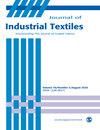Fe3O4/SiO2/polymer hybrid biosorbent based on an etch-fill strategy for heavy metal ion adsorption
IF 2
4区 工程技术
Q1 MATERIALS SCIENCE, TEXTILES
引用次数: 0
Abstract
Heavy metal contamination is a serious concern worldwide. In order to remove heavy metal ions from wastewater efficiently, multifunctinoal biomass-based material have been utilized. Herein, hyperbranched polymer modified cellulose biomass (HBP-CB) derived from textile waste materials ramie fibers was successfully developed by construction of Fe3O4/SiO2/polymer multiple structure through an etch-fill strategy. Specifically, Fe3O4 and SiO2 particles were introduced to the oxidation etching cellulose surface, and subsequently modified by hyperbranched polymer The adsorption behavior of the adsorbent toward two classes of heavy metal ions was investigated. The results indicated that HBP-CB owned excellent adsorption capacities for chromium and Cu(II) with maximum 123.5 mg/g and 149.0 mg/g and magnetic recovery performance in aqueous medium. These are owing to the oxidization etching biomass matrix with a higher BET surface area of 4.61 m2/g and the hybrid multiple structure modified by functional hyperbranched polymer with high dense adsorptive sites on the matrix. The adsorption behavior was well described by pseudo-second-order kinetic model and Langmuir isotherm model, revealing a rapid surface adsorption and monolayer spontaneous chemical adsorption. For recycling, 81% of adsorption capacity could be retained after five recovery cycles. These demonstrate that the hybrid multiple structure based on biomass, nanomaterials and polymer could provide sustainable and high-performance adsorption property for wastewater treatment.基于刻蚀填充策略的Fe3O4/SiO2/聚合物杂化生物吸附剂对重金属离子的吸附
重金属污染是全世界关注的一个严重问题。为了有效地去除废水中的重金属离子,利用了多功能生物质基材料。本文以纺织废料苎麻纤维为原料,通过蚀蚀填充策略构建Fe3O4/SiO2/聚合物复合结构,成功开发了超支化聚合物改性纤维素生物质(HBP-CB)。将Fe3O4和SiO2颗粒引入氧化蚀刻纤维素表面,然后用超支化聚合物对其进行改性,研究了该吸附剂对两类重金属离子的吸附行为。结果表明,HBP-CB对铬和Cu(II)具有优异的吸附能力,在水中的吸附能力分别为123.5 mg/g和149.0 mg/g,并具有磁回收性能。这是由于氧化蚀刻的生物质基质具有较高的BET表面积(4.61 m2/g)和功能超支化聚合物修饰的杂化复合结构在基质上具有高密度的吸附位点。拟二级动力学模型和Langmuir等温线模型很好地描述了吸附行为,表现出快速的表面吸附和单层自发化学吸附。经5次循环后,可保留81%的吸附量。这表明,基于生物质、纳米材料和聚合物的复合复合结构可以为废水处理提供可持续和高性能的吸附性能。
本文章由计算机程序翻译,如有差异,请以英文原文为准。
求助全文
约1分钟内获得全文
求助全文
来源期刊

Journal of Industrial Textiles
MATERIALS SCIENCE, TEXTILES-
CiteScore
5.30
自引率
18.80%
发文量
165
审稿时长
2.3 months
期刊介绍:
The Journal of Industrial Textiles is the only peer reviewed journal devoted exclusively to technology, processing, methodology, modelling and applications in technical textiles, nonwovens, coated and laminated fabrics, textile composites and nanofibers.
 求助内容:
求助内容: 应助结果提醒方式:
应助结果提醒方式:


